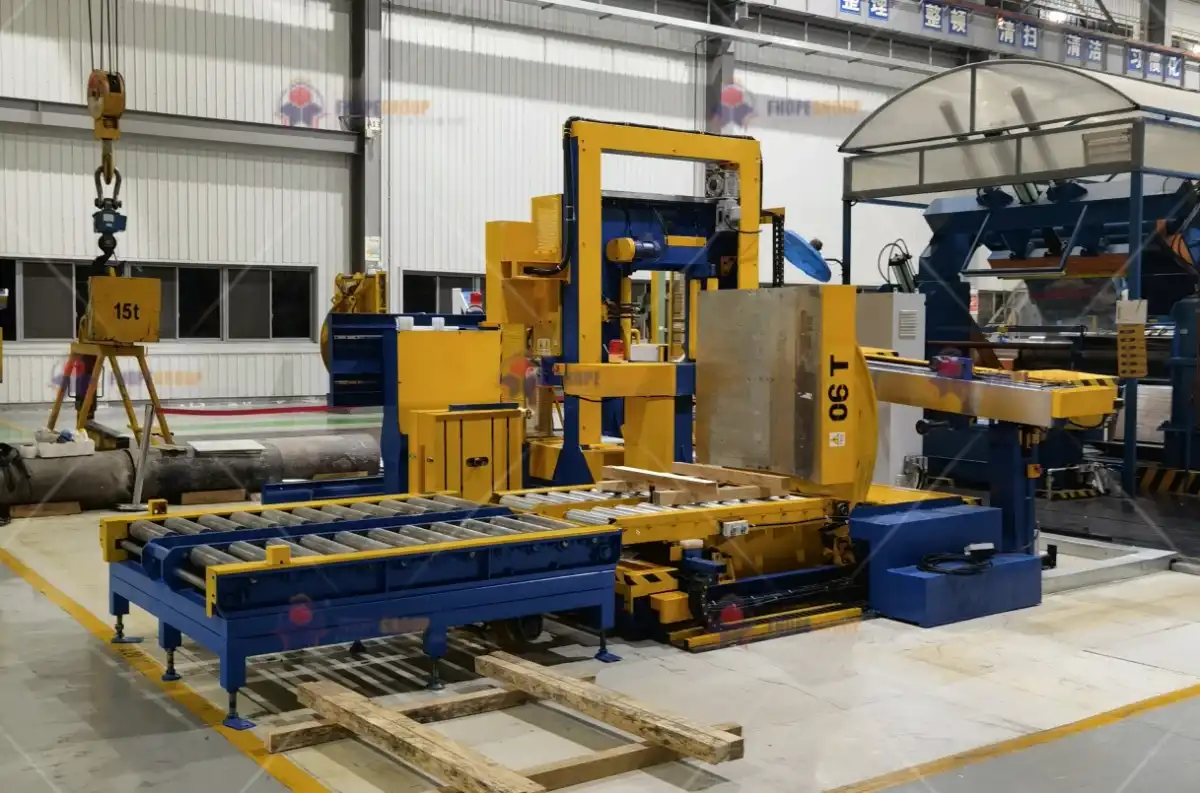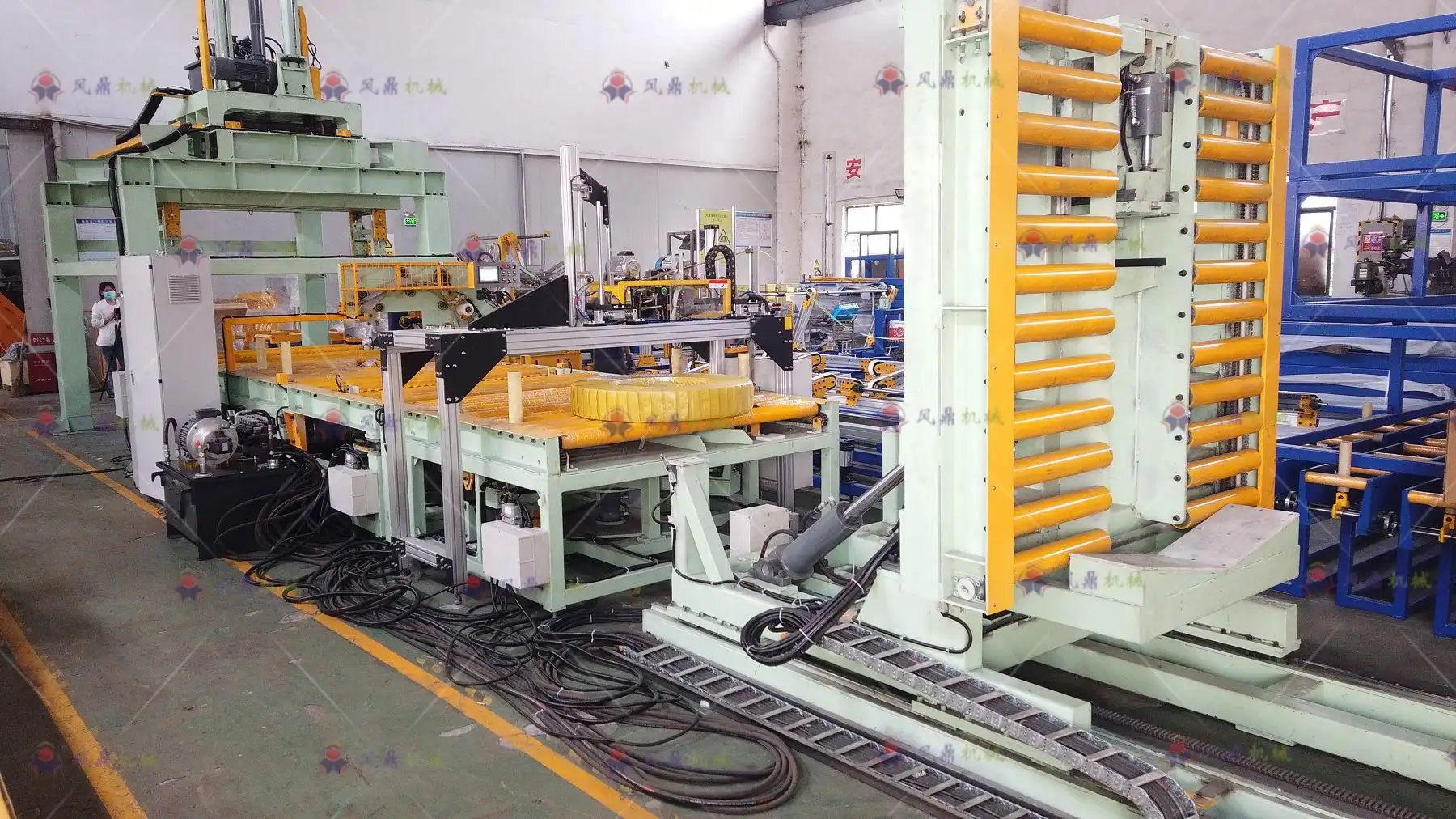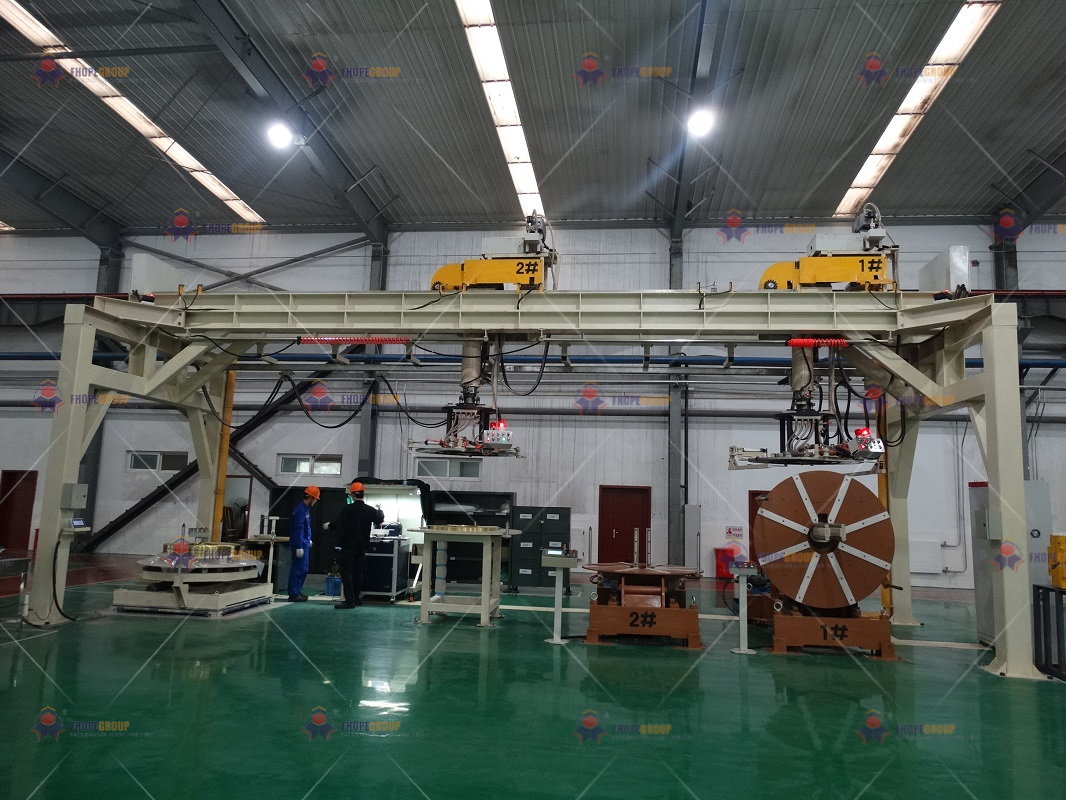Are you running a steel mill in Italy or Europe? You probably feel the constant pressure. Global competition is fierce. Energy prices are unpredictable. And finding good, reliable workers for tough, physical jobs is getting harder and more expensive every year. Your manual or semi-automatic packing area might be a source of constant headaches: production bottlenecks, inconsistent wrapping quality, and even safety concerns. This old way of doing things isn't just inefficient; it's actively costing you money and holding back your plant's true potential.
Italian steel plants are upgrading to automatic coil packing lines primarily to combat rising operational costs, improve worker safety, and boost overall efficiency. By replacing labor-intensive manual processes with reliable automation, these mills can significantly reduce their wage bills, minimize material waste, and increase their production throughput. This strategic investment directly addresses the dual pressures of a tight labor market and strict European Union regulations, making them more resilient and competitive in the global steel market.

This shift is more than just a trend. I’ve seen it happen time and again from my position as an engineer and now as a factory owner myself. It's a fundamental change in strategy. It's about looking at the end of your production line not as a cost center, but as an opportunity for huge savings and efficiency gains. Let’s break down the specific reasons why your counterparts in Italy are making this move and how it could apply to your own operations.
How does automation tackle rising labor costs and skill shortages in Italy?
Finding people for the demanding job of packing heavy steel coils is a major challenge in Italy. The work is physically taxing and repetitive. This makes it difficult to attract and retain skilled workers. When you do find them, labor costs, including wages, benefits, and social contributions, are a significant part of your operational budget. What happens when your most experienced packing team member retires? The entire process can slow down, creating a bottleneck that affects your whole plant.
Automation directly tackles rising labor costs by transforming the packing station from a multi-person manual operation into a streamlined process overseen by a single supervisor. It solves the skilled labor shortage by taking over the repetitive, physically demanding tasks. This ensures your packing line runs consistently and efficiently 24/7, without being dependent on the availability and high cost of manual labor in the Italian market.

The True Cost of Manual Labor in Steel Mills
When you think about labor costs, the first thing that comes to mind is the salary. But the true cost goes much deeper. In my early days as an engineer, I spent a lot of time on the factory floor, and I saw these hidden costs firsthand. You have direct costs like wages, overtime pay, insurance, and benefits. But then you have the indirect costs. Training a new worker takes time and resources. High turnover means you are constantly in a state of training. Human error is another big factor. An improperly strapped coil can be damaged during transit, leading to customer claims. Inconsistent wrapping can expose a coil to moisture, causing rust. These small, daily inefficiencies add up to a massive financial drain over the year. A fully automatic line eliminates almost all of these variables. The machine performs the same perfect wrap every single time. It doesn't get tired, it doesn't get distracted, and it doesn't need training.
How Automation Re-assigns Human Capital
A common fear is that automation takes away jobs. In my experience, it changes them for the better. We are not replacing people; we are replacing dangerous and monotonous tasks. The workers who used to be manually lifting, pushing, and strapping coils can be retrained for higher-value roles. They can become machine supervisors, quality control inspectors, or part of the preventative maintenance team. This transition has a powerful effect. It makes their jobs safer and more engaging. It allows you to leverage their years of experience and knowledge of your products in a more strategic way. Instead of just providing muscle, they provide intelligence to the process. This improves overall team morale and makes your operation more robust.
A Comparative Analysis: Manual vs. Automated Packing
Let's look at the numbers. A pragmatic owner like Javier always wants to see the data. The difference between a manual process and an automated one is stark. It's not a small improvement; it's a complete transformation of your end-of-line capabilities.
| Metric | Manual Packing Process | Automatic Packing Line |
|---|---|---|
| Operators per Shift | 3 - 5 | 1 (Supervisor) |
| Coils per Hour | 5 - 8 | 15 - 25+ |
| Packaging Consistency | Low to Medium | High / 100% Repeatable |
| Consumable Waste | High (inconsistent use of film/paper) | Low (optimized, pre-stretched) |
| Worker Safety Risk | High (lifting, cuts, repetitive strain) | Very Low (fenced, automated) |
| Data Integration | None / Manual Entry | Full (MES/ERP connection) |
What are the ROI and operational efficiency gains for Italian mills?
Every significant investment must be justified with a clear return. When you look at the price of a new automatic packing line, you see a large number in your capital expenditure budget. I understand that. But what I've learned is that you must also calculate the cost of not investing. The hidden costs of an old, inefficient packing process are silently draining your profits every single day through wasted materials, labor hours, and damaged products.
The Return on Investment (ROI) for an automatic coil packing line is typically seen within 24 to 36 months, driven by major savings in labor, packaging materials, and product damage claims. The operational efficiency gains are immediate. You will see a significant increase in throughput, often by 30-50%, higher equipment uptime, and a smooth, predictable workflow at the end of your production line, eliminating a common bottleneck.

Calculating the Return on Investment
Let's make this practical. An investment is only as good as its return. For a steel mill owner, the calculation is straightforward. You add up all the annual savings, and you divide your initial investment by that number.
First, labor savings. If you reassign three workers per shift from packing duties, and you run three shifts, that's a huge reduction in your direct wage bill. In Italy, this alone can amount to over €150,000 per year.
Second, material savings. An automatic orbital wrapper with a power pre-stretch unit can stretch wrapping film by 300%. This means one meter of film on the roll becomes four meters on the coil. This can easily reduce your film consumption by 20-30%, which could be another €20,000-€30,000 in savings annually.
Third, reduced damage costs. A perfectly and tightly wrapped coil is protected from moisture and handling damage. Reducing customer claims for rusty or damaged coils by even a small percentage adds directly to your bottom line.
When you add it all up, an annual saving of €200,000 is very realistic. For a line that costs €500,000, that’s an ROI of just 2.5 years. After that, it's pure profit.
Boosting Throughput and Eliminating Bottlenecks
In many of the mills I have visited, the production line itself is highly efficient. The slitter or rolling mill can produce coils at a high speed. But then everything slows down at the end. Coils start piling up, waiting to be packed. This bottleneck dictates the pace of your entire operation. Your expensive production equipment is forced to run at a slower pace because the manual packing process simply can't keep up. An automatic packing line is designed to match the speed of your production. It can take a coil, weigh it, strap it, wrap it, label it, and move it to the warehouse in a continuous, fast-moving flow. By eliminating this bottleneck, you increase the capacity utilization of your entire plant, which is a key goal for any manager looking to maximize assets.
Quantifying Efficiency Gains
Efficiency isn't just a buzzword; it's a measurable improvement. We can quantify the gains by comparing the old process with the new one. This is the kind of analysis that shows the real-world impact of automation on your daily operations.
| Factor | Manual Process | Automated Process | Improvement |
|---|---|---|---|
| Packing Time per Coil | 10-12 minutes | 2-3 minutes | ~75% Faster |
| Coils Packed per 8-hr Shift | 40 - 60 | 120 - 180+ | ~200% Increase |
| Material Consumption/Coil | Variable, often high | Optimized, consistent | ~30% Reduction |
| Downtime due to Errors | Frequent (re-wraps, etc.) | Rare | ~90% Reduction |
How do modern packing lines meet stricter European safety and environmental standards?
Operating in Europe means navigating a complex web of safety and environmental regulations. A workplace accident can be devastating, leading to investigations, fines, and a damaged reputation. At the same time, there is growing pressure from both governments and customers to be more sustainable. Using excessive amounts of plastic film or other non-recyclable materials is not just bad for the environment; it’s bad for business. Your current packing methods could be a significant liability.
Modern automatic packing lines are designed from the ground up to meet strict European standards, such as the CE Machinery Directive. They incorporate comprehensive safety systems like physical fencing, light curtains, and redundant emergency stop circuits to virtually eliminate common workplace accidents. On the environmental side, they are engineered for material efficiency, using advanced pre-stretch technology to reduce plastic film consumption by up to 30%. They are also fully compatible with modern recyclable packaging materials, helping Italian mills achieve their sustainability goals.

Engineering for Worker Safety
When I design a packing line, safety is the first priority. It’s not an add-on; it’s built into the core design. The entire automated area is enclosed by high-strength safety fencing. Access gates are fitted with interlock switches, so if a gate is opened, the machine stops immediately. We use light barriers at the entry and exit points of the line. If a person or object breaks the beam while the machine is in its cycle, it will perform a safe stop. This is a world away from a manual packing station, where workers are in constant proximity to moving forklifts, heavy coils, and sharp steel strapping. The most common injuries in these areas—back strain from lifting, cuts from strapping, and repetitive motion injuries—are completely eliminated with an automated system. This isn't just about compliance; it's about taking care of your people.
The Green Advantage: Material and Energy Savings
Sustainability is a key challenge for the steel industry. An automatic packing line can be a surprising source of environmental wins. The biggest impact is on material reduction. Our orbital wrappers have powered pre-stretch carriages that stretch the film as it's applied to the coil. A good system can achieve a 300-400% stretch ratio. This means you use significantly less plastic to achieve a secure, protective wrap. This translates to a lower carbon footprint and a direct reduction in your purchasing costs. Furthermore, these systems can be designed to work with newer, more eco-friendly materials, including films with recycled content. Energy consumption is another factor. A single, efficient automated line uses far less energy than a team of workers operating multiple pneumatic or electric hand tools throughout a shift. This directly supports the goal of reducing unit energy consumption.
Compliance and Certification
Meeting regulatory standards is not optional. A well-designed automatic line makes compliance straightforward. We build our machines to meet or exceed all relevant international and European standards. This provides peace of mind and ensures you will pass any safety or environmental audit.
| Standard | Manual Packing Challenges | How Automation Complies |
|---|---|---|
| CE Machinery Directive | Hard to guarantee safety, many moving parts and human interactions. | System is sold as a single, certified machine with integrated safety. |
| ISO 12100 (Risk Assessment) | High risk of human error, lifting injuries, cuts. | Risks are identified and engineered out of the process. |
| EN 415 (Packaging Safety) | No inherent safety logic. | Conforms to specific safety requirements for packaging machines. |
| EU Packaging Waste Directive | High, un-optimized material use. | Minimizes material use through pre-stretch and precision. |
My Take: Why a ‘Total Solution’ Partner is More Valuable Than an Equipment Supplier
You can buy a machine from a catalog. The transaction is simple. You pay your money, and a crate arrives at your factory door. But your steel mill is a complex, integrated system. What happens when that new machine needs to communicate with your conveyor system? Or when it needs to receive data from your plant's MES system? A standalone piece of equipment, bought in isolation, often creates more problems than it solves. This is something I learned early in my career, and it’s why I built my company, SHJLPACK, on a different principle.
A 'total solution' partner is more valuable than an equipment supplier because they provide a complete, integrated system designed for your specific needs, not just a machine. This partnership includes everything from the initial consultation and custom engineering to seamless integration, installation, and long-term support. This approach ensures your investment solves your strategic challenges and delivers maximum value, helping you achieve critical goals like digitalization and operational excellence.

Beyond the Machine: The Consultation and Design Phase
When a client comes to us, I tell my team not to open a catalog. The first step is always to listen and ask questions. We need to understand your entire process, from the moment a coil comes off the slitter to the moment it’s loaded onto a truck. We analyze your coil sizes, weights, production rates, and factory layout. We discuss your goals. Are you focused on speed? On cost reduction? On improving package quality for a specific customer? This deep understanding is the foundation of a successful project. Based on this, we design a solution that fits your factory like a key in a lock. It's not about selling you what we have; it's about building you what you need. This philosophy comes from my own experience starting a factory. I know that every square meter of floor space and every dollar of capital is precious.
The Critical Role of Integration and Commissioning
This is where a partnership really shows its value. A modern steel plant is a data-driven environment. Your goal of implementing MES and IoT sensors is the right one. Your packing line must be part of that digital ecosystem. A true partner ensures this happens. The PLC of the packing line needs to "talk" to your MES. This means exchanging data in real-time. The MES sends the coil ID, dimensions, and the required packing recipe. The packing line executes the job and sends back confirmation, material consumption data, and weight. We handle this integration. Our engineers work with your IT and operations teams to ensure the communication is seamless. We don't just deliver a machine; we commission a fully functional, integrated system. This is what 'Total Solution' means.
Long-Term Support and Future-Proofing
My relationship with a client does not end when the final payment is made. It truly begins the day the line starts running. I built my business to be successful, and I know that my success is tied to my clients' success. We are partners for the entire lifecycle of the equipment. This means providing clear documentation, training your operators and maintenance staff, and ensuring you have access to critical spare parts to minimize any potential downtime. It also means thinking about the future. Your business will grow and change. We can help you adapt your packing line for new products, higher speeds, or new packing materials down the road. You are not just buying a machine for today; you are investing in a platform for the future, with a partner who will be there to support you.
Conclusion
Upgrading to an automatic coil packing line isn't just an equipment purchase. For Italian steel plants, it's a strategic investment in efficiency, safety, and long-term competitive strength.





